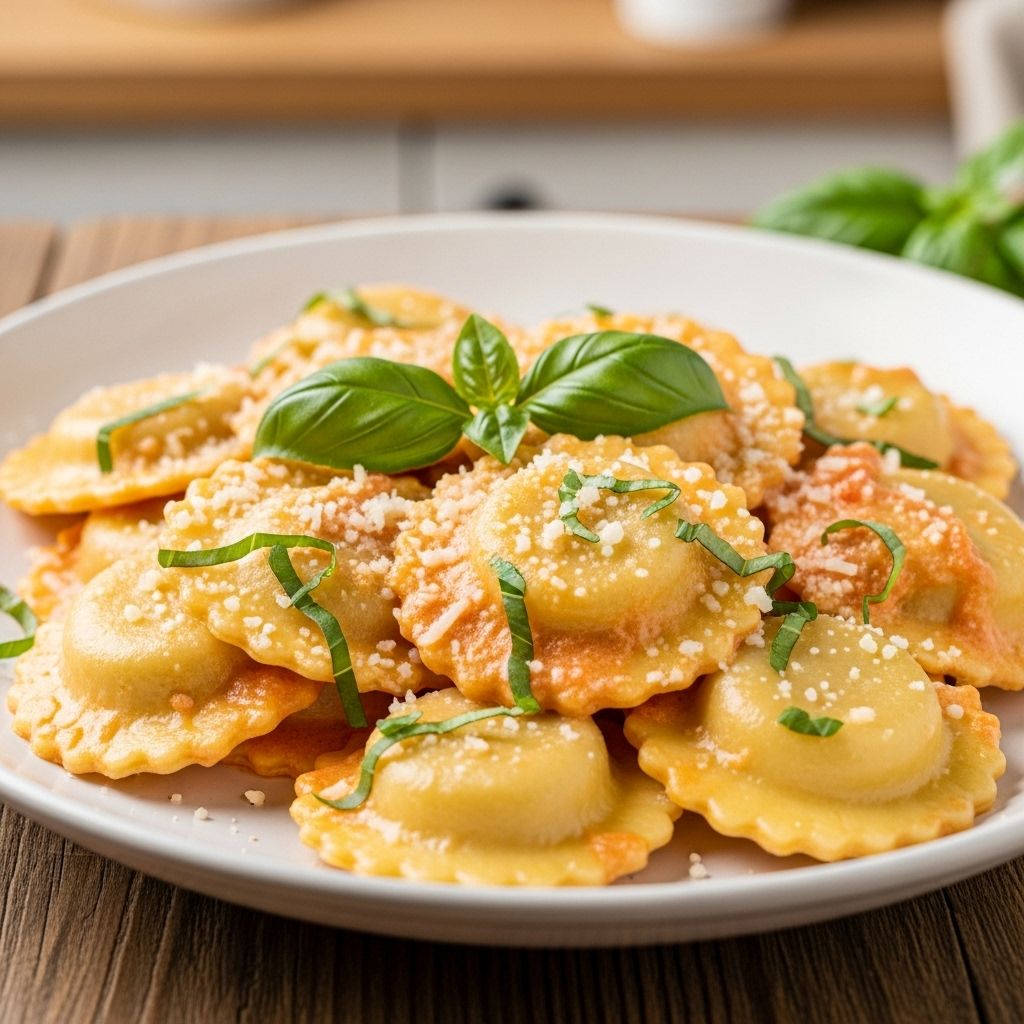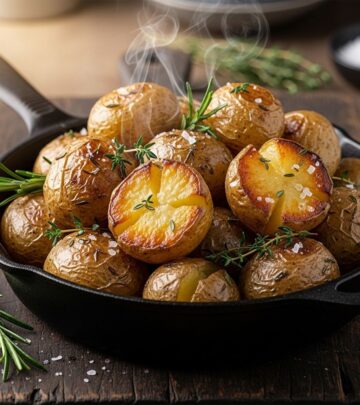Homemade Four Cheese Ravioli Recipe: 6 Simple Steps
Discover the art of homemade four cheese ravioli, from crafting fresh pasta to creamy cheese filling and a rich pesto cream sauce!

Image: HearthJunction Design Team
Homemade Four Cheese Ravioli: The Ultimate Italian Comfort Food
There are few dishes more comforting and universally loved than homemade ravioli. Stuffed with a blend of creamy, melty cheeses and served with a pesto cream sauce, four cheese ravioli stands out as a timeless Italian classic. This guide walks you through every step: from mixing the pasta dough to constructing and cooking your ravioli, and finally, to pairing it with a luscious sauce for restaurant-worthy results.
Ingredients
Pasta Dough
- All-purpose flour
- Large eggs
- Salt
- Water (as needed)
Four Cheese Filling
- Ricotta cheese
- Shredded mozzarella
- Grated provolone
- Grated Parmesan cheese
- Fresh basil and parsley (or dried herbs if fresh is unavailable)
- Salt & black pepper
- 1 egg (to bind the filling)
Pesto Cream Sauce
- Prepared basil pesto
- Heavy cream
- Salt and pepper, to taste
Step-by-Step Instructions
1. Preparing the Pasta Dough
The secret to tender, yet sturdy, ravioli is a well-kneaded, elastic pasta dough. Here’s how you can make it from scratch:
- Measure and Mix: On a clean surface, mound the flour and create a well in the center. Crack the eggs into the well, sprinkle in the salt, and slowly begin to incorporate the flour into the eggs using a fork.
- Knead: Once the mixture starts to come together, use your hands to knead it until smooth, about 10 minutes. Add small amounts of water if the dough is too dry.
- Rest: Wrap the dough in plastic wrap and let it rest for at least 30 minutes. This step is crucial for gluten development and a tender result.
2. Crafting the Cheese Filling
A four-cheese blend is the heart of this ravioli. For the best results, use fresh cheeses and aromatic herbs:
- Combine Cheeses: In a bowl, mix together ricotta, mozzarella, provolone, and Parmesan.
- Add Herbs: Stir in finely chopped basil and parsley. Adjust seasonings with salt and pepper.
- Bind: Add one beaten egg to help the filling hold together during cooking.
- Chill: Cover and refrigerate the filling until you’re ready to assemble the ravioli. This firms it up, making stuffing easier.
3. Rolling Out the Dough
Rolling the dough thin enough is essential for delicate ravioli that cooks quickly and evenly:
- Divide: Cut your rested dough in half.
- Roll: On a floured surface, roll each half into a thin rectangle (about 1/16-inch thick) using a rolling pin or pasta machine. Avoid overworking the dough side-to-side; roll top to bottom for even thickness.
4. Assembling the Ravioli
- Placement: Spoon small mounds (about 1 teaspoon each) of filling onto one sheet, spacing them evenly in rows about 1 inch apart.
- Moisten: Brush the spaces around the filling lightly with water to help the pasta sheets stick together and seal.
- Top Layer: Carefully lay the second sheet of dough over the filling. Press gently around each mound to remove air and seal the edges.
- Cut: Use a sharp knife, pastry wheel, or ravioli cutter to separate each piece.
- Seal: Press edges with a fork for a decorative and secure seal.
5. Cooking the Ravioli
- Boil: Bring a large pot of salted water to a gentle boil.
- Cook: Add ravioli in batches. Once they float to the top (2-4 minutes), they’re done.
- Transfer: Use a slotted spoon to carefully remove and drain.
6. Preparing Pesto Cream Sauce
- Blend: In a saucepan, gently heat prepared pesto and heavy cream together, stirring until smooth and warmed through.
- Season: Taste and adjust with salt and pepper as desired.
- Serve: Spoon the sauce over hot, freshly cooked ravioli.
Tips for Perfect Ravioli
- Use Fresh Ingredients: Fresh herbs and cheeses make a noticeable difference in flavor.
- Don’t Overfill: Too much filling can cause ravioli to burst during cooking.
- Seal Tightly: Ensuring there’s no air around the filling prevents them from opening in the water.
- Freeze for Later: Place uncooked ravioli on a baking sheet in a single layer and freeze. Once solid, transfer to a bag or container and cook straight from frozen, adding an extra minute to the boiling time.
Serving Suggestions
- Garnish: Top with extra grated Parmesan and a sprinkle of fresh herbs for color and flavor.
- Accompaniment: Serve with a simple arugula salad and crusty Italian bread to round out the meal.
- Beverage Pairings: A crisp white wine, such as Pinot Grigio or Sauvignon Blanc, complements the richness of the cheese beautifully.
Nutrition Information
The nutrition profile of homemade four cheese ravioli will vary based on portion size and sauce used, but a typical serving is rich in protein and calcium, while also being relatively high in fat due to the cheeses and cream sauce. For a lighter option, you can opt for a tomato-based sauce or use part-skim cheeses in the filling.
Frequently Asked Questions (FAQs)
Can I use a food processor for pasta dough?
Yes, you can mix the dough in a food processor with a dough blade, but knead it by hand at the end to ensure elasticity.
How do I prevent ravioli from sticking?
Dust each ravioli with flour or semolina before cooking, and avoid stacking them together while prepping.
What is the best way to store homemade ravioli?
Store uncooked ravioli in a single layer in the refrigerator for up to 2 days, or freeze for longer storage.
Can I add other fillings?
Absolutely! Spinach, mushrooms, or roasted vegetables are popular additions to cheese ravioli.
How can I make this recipe gluten-free?
Use a gluten-free flour blend designed for pasta to substitute the wheat flour in the dough.
Recipe Variations
- Spinach Four Cheese Ravioli: Mix in thawed, drained, and chopped spinach to the cheese filling for extra flavor and nutrition.
- Mushroom Cheese Ravioli: Saute and finely chop mushrooms to add an earthy richness to your cheese mixture.
- Lemon Zest: Add a touch of lemon zest to the filling for brightness.
- Sauce Swaps: Try serving with a classic marinara, brown butter and sage, or an Alfredo sauce for a different twist.
Homemade Ravioli Tools & Equipment
- Rolling Pin or Pasta Machine: For rolling dough thinly and evenly.
- Pastry Brush: For applying water to seal ravioli edges.
- Sharp Knife, Pastry Wheel, or Ravioli Cutter: For cutting individual ravioli pieces.
- Large Pot and Slotted Spoon: For boiling and removing ravioli gently.
Summary Table: Cheese Filling Choices
| Cheese | Texture | Flavor Profile |
|---|---|---|
| Ricotta | Creamy, soft | Mild, fresh |
| Mozzarella | Melty, stretchy | Mild, milky |
| Provolone | Firm, grated | Sharp, tangy |
| Parmesan | Grainy, hard | Nutty, salty |
Final Thoughts
Homemade four cheese ravioli is a rewarding kitchen project that delights with every bite. The combination of tender pasta, rich and creamy filling, and a flavorful sauce elevates any dinner into a memorable occasion. With practice and creativity, you can master this Italian classic and adapt it to your own tastes. Serve your homemade ravioli with pride, knowing each step—from dough to sauce—showcases the best of Italian home cooking.
References
- https://www.allrecipes.com/recipe/213131/homemade-four-cheese-ravioli/
- https://www.allrecipes.com/recipes/16855/pasta-and-noodles/pasta-by-shape/ravioli/
- https://www.allrecipes.com/article/making-ravioli/
- https://www.youtube.com/watch?v=ti33gTlwJnA
- https://it.pinterest.com/pin/homemade-four-cheese-ravioli–1970393572871820/
Read full bio of Srija Burman












